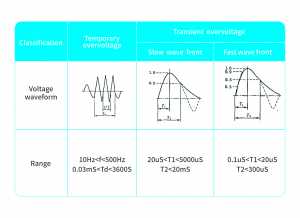Overvoltage is a concept that engineers often hear in the field of power electronics. But many engineers don’t understand this concept very well. Here, I’ll share what I know with everyone, and sincerely hope it will help.
- System overvoltage
First of all, what is the system overvoltage? In a power system, any waveform whose peak voltage exceeds the highest peak voltage in the normal operation of the power system belongs to system overvoltage. System overvoltage is an abnormal state in the operation of the power system. The probability and severity of overvoltage are determined by the local climate and design level of the power system. In the normal operation of the power system, it is almost impossible to predict the system overvoltage.
According to the location of overvoltage, it can be divided into two categories, one is external overvoltage, the other is internal overvoltage. The external overvoltage, also known as lightning overvoltage, is divided into direct lightning and induced lightning. The internal overvoltage mainly includes power frequency overvoltage, resonance overvoltage and switching overvoltage. The classification is shown in Figure 1.

According to the duration of overvoltage, it can be divided into temporary overvoltages and transient overvoltages. Temporary overvoltages refer to power frequency overvoltage with long duration, while transient overvoltages last for a short time, only a few mS, even uS level, which can be highly damped oscillation wave or non-oscillation wave. Temporary overvoltages mainly include power frequency overvoltage and resonance overvoltage. The duration of these overvoltages is relatively long, which is related to the structure, capacity, parameters, operation mode, fault conditions of the power system, and device characteristics of various safety protection devices; transient overvoltages include switching overvoltage and lightning overvoltage. The duration of these overvoltages is relatively short. It can be subdivided into fast wave front overvoltage with wave front time between 0.1us and 20us and slow wave front overvoltage with a peak time between 20us and 5000us. The classification is shown in Figure 2.

The typical waveform of overvoltage is as follows, as shown in Figure 3.

2、 Overvoltage category (OVC)
Usually, the type of overvoltage mentioned by engineers is the description of transient overvoltage. According to the severity, it can be divided into four categories: OVC Ⅰ, OVC Ⅱ, OVC Ⅲ and OVC Ⅳ. OVC Ⅰ represents the best environment and OVC Ⅳ is the worst. The overvoltage category is a concept with probability. OVC Ⅱ represents the severity of transient overvoltage in a certain area,and the probability is OVC Ⅱ.
OVC Ⅳ refers to the overvoltage of the equipment used at the entrance of the building. For example electricity meter.
OVC Ⅲ refers to the overvoltage of fixed installation or equipment with special requirements for reliability or availability. For example, a fixed switch.
OVC Ⅱ refers to the energy-consuming equipment which takes power from fixed installation equipment. For example various household appliances or similar loads.
OVC I refers to the over-voltage of the electrical equipment connected to the circuit which has taken measures to suppress the transient overvoltage.
3、 Influence of overvoltage category on power supply design
The purpose of classifying system overvoltage is to guide the design of safe distance of electronic equipment, and the design of power supply is also applicable.
Taking IEC 62368-1:2014 as an example, in order to ensure the safety of electronic equipment, it is necessary to reserve enough safety distance. How much distance is safe? The standard gives guidance requirements. For the environment with the transient voltage (also known as the required withstand voltage) of 2500V, the electrical clearance of reinforced insulation is required to be 3.0mm, as shown in Figure 4.

Why is the transient voltage 2500V? According to table 13 in the standard, when the equipment power supply grid voltage is 230VAC, the transient voltage of OVC II is 2500V, as shown in Figure 5. Without special requirements, the overvoltage category of electronic equipment is mainly OVC Ⅱ, such as computers.

The above is mainly about the information sharing of the system overvoltage and its function, and I hope it will help the engineers.
Meanwhile, MORNSUN, as a leading manufacturer who provides one-stop solutions of power supplies, has a line of products for a wide range of applications engineered to meet the power supply challenges for engineers. Its broad portfolio covers multiple power ranges and includes AC-DC converter, DC-DC converter, transceiver module, and SiC/GaN driver power supply, etc. All of these products feature compact size, high power density, excellent EMC performance, reliable technical specifications and leading efficiency. If you are looking to design a power supply for your system with ease, then MORNSUN has the solutions for you.
For more information, please visit www.mornsun-power.com.








